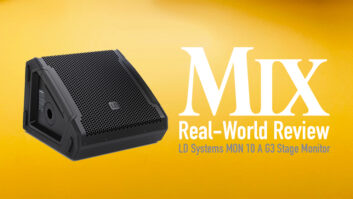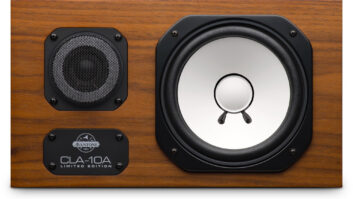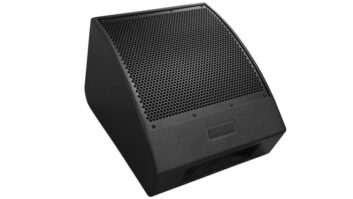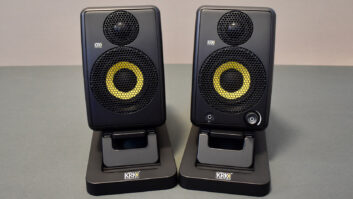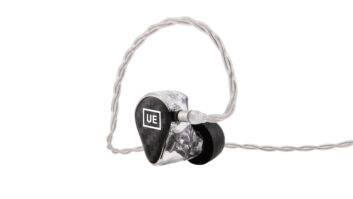Speaker components have improved considerably during the past 20 years. Distortion is lower, power hand- ling is higher, and bandwidth is wider. Despite the improvements, however, monitoring systems are still the weak link when compared to any electronic hardware, digital or analog. The obstacle is not the lack of progress but the fact that the largest collection of variables ever thrown at transducer technology is called “a room with stuff in it.” This obstruction can make it difficult to assess the health of your monitoring system.
In Mix’s February issue, Bob McCarthy wrestled with that thorny beast known as “room tuning.” This article focuses on monitor health and channel balance issues, including troubleshooting tips-from the console to the drivers-for both live and studio applications.
HOW DEEP?There’s plenty of talk about the sound of outboard gear. From converters to mic preamps, equalizers to compressors, these are devices that can be abused without fear of destruction and can be appreciated for what can be rather subtle nuances. There is nothing subtle about monitoring systems. A cabinet at the near-field position will sound much different on a bookshelf, on the floor or next to an identical system. All this before we drive ’em hard, blast ’em with feedback or accidentally remove the reference clock from a piece of digital gear. Ouch!
Have you ever wondered how much abuse a monitor system can take before its performance is degraded? Precise evaluation requires test equipment as well as a test environment (an anechoic chamber), not to mention a level of technical expertise that goes well beyond the scope of this article and the green in your wallet.
However, a basic investigation requires only a minimal electronic tool kit and some comparative analysis. In the sidebar “Basic Tools,” Table 1 lists the necessary electronic accessories, including alternatives for those of you with more cash. More extensive troubleshooting techniques will be detailed next month in this column. For example, with an oscillator and a voltmeter, it will be possible to confirm signal integrity from source to destination. Additional tools include a pink-noise generator, a sound-pressure level meter and your earplugs of choice.
ZOOM THISWhether built-in or freestanding, large speaker systems have the ability to move more than air. Using a continuously variable oscillator, start at 1 kHz and sweep downward into the bass region. You might be horrified to hear how easily walls, floors, racks and light fixtures can be coaxed into a cacophony of sympathetic vibrations. It is not necessary or recommended to go beyond a “comfortable” listening level for this test.
Other “room interaction” issues will reveal themselves when panning any sound source from left to right (or right to left, in some parts of the world). Try this test with kick, snare, vocal, crunchy electric guitar or pink noise. If differences were noticed, especially at low frequencies, would you suspect the monitors or the room? You can swap power amp channels easily enough-crossovers and drivers require a little more effort. Be sure to exercise every connection between the console and each speaker component. If nothing changes, the problem is with the room and/or cabinet placement.
LITTLE DAVIDNear-field monitors minimize room interaction, improving mid- to high-frequency accuracy (imaging). Yet many fall short of providing adequate low-frequency information. Subwoofers may seem to be a gimmick and are admittedly tricky to set up, yet the two octaves below 80 Hz are important enough to be worth an experiment. Satellites with less than an 8-inch woofer may need help in the octave above 80 Hz.
Absolute (coarse) polarity is critical-an out-of-phase subwoofer will create a “hole” at the crossover region rather than a smooth transition. Most times you simply want the subwoofer to pick up where the satellite rolls off. For greater flexibility, get a subwoofer that includes a crossover for itself as well as the “satellite” speakers. There will always be phase shift in the crossover region-it’s the inherent nature of the filters-so look for the ability to fine-tune the phase, in addition to polarity.
Hearing and feeling the bottom helps the listener/engineer create better mixes. Cleaning up subsonic slop makes room for the “real” bass instruments. Reducing the guesswork and using less EQ will improve mix compatibility-no more bottom-heavy mixes. All of the aforementioned items serve a dual purpose by reducing the stress on Chihuahua-sized woofers.
LESS FATIGUEAnytime a monitor chart shows near-flat frequency response, you are looking at the soft-focused Reader’s Digest version. It’s way more complex than that! Monitors are measured in an anechoic chamber, not in a studio environment, where each boundary-wall, floor, console-can increase low-frequency response. A freestanding monitor with no nearby boundaries will have less bass than a soffitt-mounted monitor, assuming the environment is well-designed.
Each driver in a monitoring system is much more like a stringed instrument than you might have ever imagined. I could show you charts for days, but Fig. 1 gets to the crux of the biscuit with a down and dirty crosscut view. Like a guitar that was “in tune when you bought it,” a driver starts out with a resonant frequency and a series of complex harmonic overtones that constitute its sonic fingerprint. A loudspeaker played hard will eventually go flat, shifting the resonance downward and permanently altering the fingerprint.
MARGIN OF SAFETYPowered (active) monitors typically have some sort of driver protection either in the form of a peak limiter or a safety relay. Passive monitors are further down on the food chain, and the installer should include not only a safety valve (a fuse), but also a healthy gain structure between source and power amp. Your system should be calibrated so that a comfortable listening level occurs when the control-room level pot “lives” between straight up and the 3 o’clock position.
Once upon a time, I was fast-winding an analog tape past what should have been the end of any recorded material. A sudden screech and then an eerie silence jolted me back to consciousness too late to pull my finger away from the heads. A 1-amp fast-blow fuse did not react in time to protect all of my beloved Radio Shack Minimus 7s-four in a passive-surround configuration. At least they were fused. Fig. 2 shows the distorted bobbin after the voice coil overheated. The two surviving tweeters, which were made in Japan, didn’t sound anything like the two new replacements from Malaysia. Yeah, I know these are cheap consumer-grade speakers. My “real” monitors are by Dynaudio Acoustics, model BM15A.
MORE FATIGUEMonitor fatigue gradually occurs over time, so you may not notice the change until a driver fails and is replaced. The difference may also be related to manufacturing tolerances. If you read no further, at the very least, keep two spares and always replace in pairs. If one tweeter dies, replace both, dating the new and labeling the used, working driver. Some near-field monitors are cheap enough that an extra pair of monitors can be less expensive than buying spare drivers. You can always use them in a passive surround configuration, which will be discussed in a future article.
YOU HEAR FOOTSTEPS?Monitor selection is not an easy task. The terms “accurate” and “pleasing” can be dissimilar qualities. An accurate speaker may appear unremarkable at first audition, while a more pleasing model might provide instant gratification suitable for those moments of “easy listening,” when the ear is off duty. Great-sounding speaker systems are easy to come by, but the path toward greater accuracy requires many deliberate steps.
The natural, free-air resonance of a woofer changes when installed in a cabinet, sealed or ported. Disconnect one wire from a passive monitor and tap on the woofer with your finger, listening closely for its natural resonance. Next, alternate between connected and disconnected, with the power amp on. You should notice more resonance with the amp disconnected. This demonstrates Damping Factor, the relationship between the power amp’s output impedance and the speaker’s nominal impedance. DF is undermined by cable resistance, hence the hunger for cable a la Monster.
Powered monitors have made Damping Factor less variable by reducing the cable length from the power amp to the driver to about 12 inches. In addition, an active crossover network before the power amps (rather than a post-amp passive network) results in better damping for both woofer and tweeter. An active system may seem a little less exciting than its passive cousin, but it is now more accurate, with tighter bass and smoother treble.
REAL MAGIC (NOT SNAKE) OILAll wire has resistance (stated in ohms per foot and referenced to room temperature) that increases when hot and decreases when cold. This applies to voice-coil windings as well, so when you continuously blast those boom boxes, heat makes the coil less effective at delivering transients. If you listen at loud levels for an extended period of time, the monitors will sound dull and floppy from fatigue. Your ears get tired, too.
There is one, quite remarkable, “solution,” called Ferrofluid (www.ferrofluidics.com), a magnetic material suspended in a viscous liquid designed to fill the magnetic air gap in which the voice coil is suspended. The fluid provides three benefits: greater transfer of magnetic energy, “hydraulic” damping of the resonant diaphragm and the transfer of heat from the coil to the magnet assembly. It’s not hard to see, and hear, that Ferrofluid makes a driver more efficient, less colored and better equipped to deliver transients even when driven hard.
The manufacturer’s sample pack included fluids for tweeters through subwoofers, including one optimized for midrange and high-frequency compression drivers. I was willing to sacrifice a Minimus 7 or two to see how much magic I could conjure out of them.
Fig. 3 shows the powerfully focused magnet assembly attracting the fluid from its container. It took some experimenting to achieve an optimum, repeatable mic placement. Fig. 4a shows a 500Hz square wave through an unmodified tweeter, captured with an AKG C-300 with an omni capsule and a Great River transformerless mic preamp. Fig. 4b shows the same tweeter’s response after Ferrofluid treatment. Notice that the amount of overshoot decreases with treatment.
That’s all the room I have for this month. Look for Part Two in the next issue. Ciao!
Compared to buying the latest audio processing box, tube mic or hot software plug-in, audio tools aren’t always high on anyone’s list of “must-have” future purchases. However, here are some recommendations of basic items for anyone who’s serious about getting into audio maintenance/ troubleshooting. Test gear can get expensive, so I tried to go easy, offering some lower-cost products as well. Better quality items, such as the Fluke 8060A, are not cheap, but they make a tech’s life easier. Note that all the listed voltmeters measure RMS volts, and the more expensive digital and analog meters also measure dB.Most of these products are available via mail-order tool suppliers such as MCM Electronics (www.mcmelectronics.com). As an alternative, check out sites such as www.big-list.com, which features used gear from several dozen dealers-listed alphabetically and regularly updated.


